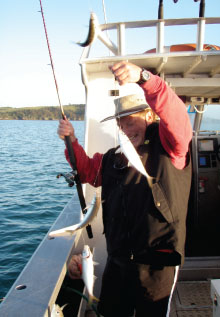Livebaits for Kingfish
Kingfish are suckers for live bait. Kahawai, jack mackerel, piper, slimy mackerel and koheru all make good livebaits for kingfish: trolled, fished deep or suspended under a balloon/float from a boat or the shore.
 Kahawai is the premium inshore livebait for large kingfish, and small kahawai are also attractive to smaller kingfish.
Kahawai is the premium inshore livebait for large kingfish, and small kahawai are also attractive to smaller kingfish.
Kahawai can be caught on bait or by using lures, from a boat or off the shore. Small jigs or softbaits are effective, otherwise slow-troll spoons or jigs around the edges of kahawai schools.
A downrigger and/or paravane can make all the difference to trolling success, getting your lure down a few metres into the strike zone.
Jack mackerel (yellowtail) are popular livebaits. Catch them on bait flies (sabikis) at night under lights, or early in the morning. Add bait to the flies if the fishing’s hard. Mackerel like shallow bays and reefy areas around headlands and islands, as well as harbour channels, breakwaters and wharves.
Silvery-blue koheru are only found in clear, oceanic water around reefs and headlands and offshore islands. Kingfish love them.
Use small metal jigs (7-18g) or tiny baits fished on small, unweighted hooks in the berley trail. Don’t overcrowd the bait tank, since koheru need more space than jack mackerel.
Slimy mackerel and piper (garfish) are also excellent, but fragile, livebaits. Slimy mackerel take bait flies, small jigs, saltwater flies and softbaits and are often mixed in with jack mackerel schools; piper can be netted or caught on small hooks baited with slivers of skipjack or pilchard under a quill float fished down a berley trail. For piper, try slowly retrieving the bait to trigger bites.
Rigging live bait
 Small baits should be hooked through the nose in front of the eyes, as should any livebaits you want to troll. Match the hook size to the bait, since over-large hooks will kill the bait and are very obvious to kingfish. Small baits can be fished on 5/0 or 6/0 hooks, or smaller. Use a relatively light trace so that the bait’s movements aren’t hampered too much.
Small baits should be hooked through the nose in front of the eyes, as should any livebaits you want to troll. Match the hook size to the bait, since over-large hooks will kill the bait and are very obvious to kingfish. Small baits can be fished on 5/0 or 6/0 hooks, or smaller. Use a relatively light trace so that the bait’s movements aren’t hampered too much.
With larger baits – kahawai, large jack mackerel and big koheru – 7/0-12/0 hooks and heavier trace are appropriate. Large baits are usually nose-hooked or bridle-rigged for trolling, but back-hooked baits sometimes work best, perhaps because they naturally swim deeper when trolled. Back-hooking baits is usual when fishing them under a float or a balloon; nose-hooked baits work better fished deep under a sinker on a trace (back-hooked is another option here) or above the sinker on a dropper.
Take care not to damage a bait’s backbone with the hook. Always place the hook so the hook point angles upwards, away from the bait’s body
Trolling livebaits
 Livebaits can be trolled at or below the surface. The basic rig consists of a metre or two of heavy trace (40-75kg), a suitable short-shank, circle or livebait hook and a heavy-duty swivel. Deeply sunk livebaits are deployed using a downrigger or a breakaway trolling wing.
Livebaits can be trolled at or below the surface. The basic rig consists of a metre or two of heavy trace (40-75kg), a suitable short-shank, circle or livebait hook and a heavy-duty swivel. Deeply sunk livebaits are deployed using a downrigger or a breakaway trolling wing.
Over shallower, reefy territory and around headlands, surface-trolled livebaits come into their own. A balloon can be added to the rig, restricting the bait’s ability to flee a pursuing kingfish and providing fish-attracting colour and commotion as it’s towed through the water.
Kahawai and slimy mackerel are premium troll baits. Large kahawai slow-trolled around headlands and islands can attract monumental kingfish, although sharks like them too.
Kahawai can also be fished under a balloon, from shore or out of an anchored or drifting boat. Set the bait a couple of metres below the surface. Piper work well fished under small floats.
Smaller livebaits work better on a range of fish sizes. Koheru are a good surface bait option, but jack mackerel are better fished deep. Jack mackerel and koheru are excellent baits fished over deep reefs on weighted rigs. The boat can be anchored or allowed to drift. The same technique works off the shore, particularly from wharves and jetties. Keep the trace length to around a metre.
Hooking and playing kingfish
 Kingfish usually engulf small trolled baits, hooking themselves, and the same is true of small deep-sunk baits – sometimes it’s best to leave the rod in the holder with the reel in gear. With larger baits, and whenever you fish kahawai under a balloon, it pays to allow the kingfish to run a short distance before setting the hook.
Kingfish usually engulf small trolled baits, hooking themselves, and the same is true of small deep-sunk baits – sometimes it’s best to leave the rod in the holder with the reel in gear. With larger baits, and whenever you fish kahawai under a balloon, it pays to allow the kingfish to run a short distance before setting the hook.
Surface-trolled livebaits and baits fished under a balloon are taken in a spectacular explosion of spray. The reel should be set with just enough drag pressure to prevent overruns. Let the fish run with the bait, before tightening to set the hook.
A live bait fished off the downrigger has usually been well swallowed by the time the line comes up tight on the rod, so the reel can be left in gear. Don’t troll baits too far behind the boat or let fish run far with the bait before setting the hook when fishing deep – kingfish will find the rocks before you can exert any control.
In shallow water, a gentle approach to playing kingfish works best. Fish hooked on trolled or surface livebaits can often be led away from danger by applying firm, steady pressure as the boat idles away into deeper water. Once in the clear, apply as much pressure as necessary to boat the fish.
Species:Kahawai Kingfish Piper Shark
